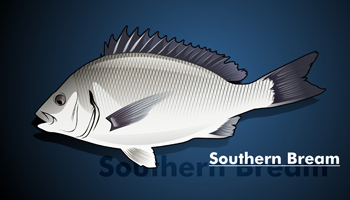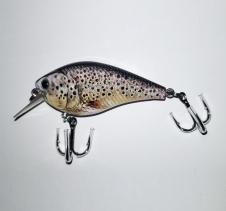Visit Our Online Store! $7 AusPost Parcel Post Delivery FREE Postage for orders $45 and over!
* Shipping rates above apply to Australian Customers only
Bagging bream, the secrets to success.
Catching Bream. Fishing with Bait and Lures.
 Bream are a species of saltwater fish common to the east of Australia. There are two main varieties, black bream and yellowfin bream. Black bream tends to inhabit the lower southern regions of Eastern Australia, while yellowfin bream sticks to the central east and north east. The two species are very similar and catching them involves the same methods. Most people who have been around bream fishing a long time, or those just starting out prefer to stick with bait fishing for bream. While this is highly successful, you may find times where the bream is jumping all day however you are unable to land them using traditional bream bait. In these times, hard body lures are the winner, and the favourite lure for bream isn't what you may expect, the good old popper surface lure does the job perfectly.
Bream are a species of saltwater fish common to the east of Australia. There are two main varieties, black bream and yellowfin bream. Black bream tends to inhabit the lower southern regions of Eastern Australia, while yellowfin bream sticks to the central east and north east. The two species are very similar and catching them involves the same methods. Most people who have been around bream fishing a long time, or those just starting out prefer to stick with bait fishing for bream. While this is highly successful, you may find times where the bream is jumping all day however you are unable to land them using traditional bream bait. In these times, hard body lures are the winner, and the favourite lure for bream isn't what you may expect, the good old popper surface lure does the job perfectly.The best bream bait by far is thin chicken strips dipped in minced garlic and parmesan cheese, a surprise to you? It shouldn't be, it has been used by a fishermen in the know for the last 100 years. Bream love raw chicken, and the garlic and parmesan produces a burley which entices them to the bait. Using prawns is nowhere near as effective as raw chicken for Australian bream species.
If the above was a shock to you, then the next few lines will be even more of a shock. People heading out after bream on swimmerbaits and general diving hard bodies may struggle and wonder why, even when the bream is seen in the water there may be times where your lure just doesn't phase them. Why is this? Although bream are accustomed to their regular diets consisting mainly of shrimp, crabs, muscles and bottom dwelling fish, for some reason the effects of a popper lure (non diving surface lure) can quickly lure them from the water to the surface. The reason this happens is entirely unknown, but one thing is for sure, it definitely works.
Popper lures are long cylinder type lures with a concave front, they always float on the surface of the water, the concave front section produces a large wave which fans out to the sides, the water disturbance gets the attention of nearby fish, while the stream of water out both sides makes them an easy target point, even when the fish aren't accustomed to taking food from the surface. In the minds of many fishermen, poppers only appear when mention of species such as Giant Trevally, Salmon or Tuna are introduced, while these species love large popper lures, there is a wide range of smaller plastic popper lures that work well on a variety of species, one of them being the bream we are talking about at the moment.
Popper lures also have a huge benefit over other lures, while most other lures are prone to snags, poppers rarely drop below the surface, and if they do they normally only travel around 2cm, this means you avoid almost all common snags in the water body, saving you time and money. You may be surprised how many species the popper lure attracts, but one thing is certain, it's the ultimate bream lure.
While soft plastic grub style lures fishing along the bottom of a waterbody is by far the most common method of bream lure fishing, the popper I believe is far ahead due to it's ease of use, fishing in and around mangroves means you can position the popper in clear sight of snags to avoid them, where as underwater lures you are somewhat guessing as to where the snags will be. Bream which spot a popper will commonly leap out of the water for it, and a quick search for bream on popper lures will likely return a lot of results.
Next time you go out estuary or pier fishing, remember to have a few popper lures on hand, you may be amazed at how well they work.
Follow us on twitter: @FishTackleLures or Google Plus: +FishingTackleLuresAU
View more articles in our Australian Fishing Guide.
Enter your email address below to be updated on new fishing articles, fishing lures and special offers:
We will only email once every two to four weeks at the most, usually every 2 months.
POPULAR PRODUCTS IN OUR ONLINE STORE





